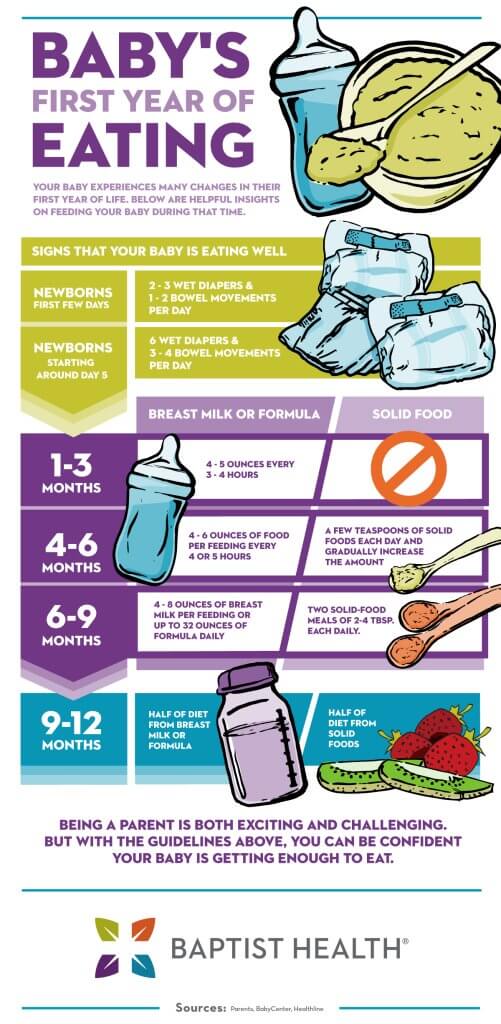Baby’s First Year of Eating

Your baby experiences many changes in their first year of life. Some of the most important have to do with their nutritional needs.
As a parent — especially a first-time parent — it’s common to have questions about feeding your baby. Whether you need a newborn feeding schedule or want to know, “How much should my 6-month-old eat?” it’s reassuring to have information from your pediatrician or other well-vetted sources.
Below are helpful insights on feeding your baby in their first year.
Baby Feeding Chart
Keeping in mind that factors like your baby’s size will affect how much food they need, below are some good guidelines.

Newborns
Babies start by consuming exclusively breast milk, formula, or some of each for their first 4 to 6 months. Their digestive system isn’t able to handle solid foods yet.
Every baby’s nutritional requirements differ, but most will need to eat 8 to 12 times per 24 hours. How long it takes a baby to satisfy its hunger will vary. Some finish nursing or empty a bottle in as little as 5 minutes, while others may take an hour to finish eating.
Nursing mothers may wonder if their baby is getting enough breast milk since measuring their consumption is impossible. Signs that your baby is eating well include 2 to 3 wet diapers and 1 or 2 bowel movements per day in their first few days, and 6 wet diapers and 3 to 4 bowel movements a day starting around day 5. You may also find your baby smacking their lips or rooting around for your nipple when they’re hungry.
Be aware that it’s normal for babies to lose up to 7% of their birth weight initially but then gain it back by 2 weeks.
1-3 Months
Your baby’s appetite will likely start increasing noticeably in this period, and they’ll be able to make it more apparent when they’re hungry. A 2-month-old typically eats 4 to 5 ounces every 3 to 4 hours.
4-6 Months
Babies this age generally consume 4 to 6 ounces of food per feeding and eat every 4 or 5 hours.
You should not start solid foods before 4 months. However, at 4 to 6 months, babies typically show signs they’re ready to try them. This includes holding their head up when in a highchair, reaching for food, and the ability to move their tongue up and down and back and forth. You’ll also notice that the tongue-thrust reflex (which helps infants breastfeed) has disappeared.
And, of course, “solid” isn’t exactly accurate. Your baby’s first foods that aren’t breast milk or formula should be 1-ingredient baby foods like pureed vegetables, fruits, and meats. It’s best to start with a few teaspoons of solid foods each day and gradually increase the amount.
6-9 Months
In this age range, a baby should still get most of its nutrients from breast milk or formula. Those nutrients should come from 4 to 8 ounces of breast milk per feeding or up to 32 ounces of formula daily.
Pediatricians recommend that you also feed your baby up to 2 solid-food meals daily, with each meal being 2 to 4 tablespoons of food. As you expand the array of foods you offer your baby, introduce them one at a time so you can identify any food allergies.
9-12 Months
Soon after 9 months, a baby should be getting half their nutrients from breast milk or formula and half from solid foods. Typically, that means 7 to 8 ounces of liquid per feeding or up to 32 ounces of formula in 24 hours.
You should continue to indulge your child’s interest in different foods, carefully cutting things into very small bites that can’t block their airway.
Positive Support for New Parents
Being a parent is both exciting and challenging. But with the guidelines above, you can be confident your baby is getting enough to eat.
And if you have questions about anything from feeding a baby to health concerns, our mother and baby care experts are here for you!
Next Steps and Useful Resources
Breastfeeding 101
How to Increase Breast Milk Supply
How to Help Boost a Baby’s Immune System
Baby Weight



